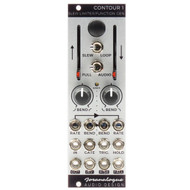Joranalogue — Contour 1
by Ellison Wolf
Whenever I see the word “Contour” I think of cars, specifically older cars with fins, pointy tail lights, and back seats as big as Manhattan [or LA, or Seattle, or…] apartments. Usually when talking about contours in terms of design, it’s almost always in a positive context. I can’t recall ever coming across a description of anything referencing bad contours or contouring. In that effect, Joranalogue’s Contour 1 has a lot to live up to in terms of its naming choice. Unsurprisingly—as is usual for the one man wrecking crew that is Joranalogue—designer Joran van Gremberghe is more than up to the task, and if anything, only elevates the word even more. While not sporting domed tail lights—though there are a couple of LED sliders!—Contour 1 is aptly named. It is a slew limiter, function generator, VCO [one that tracks quite well], LFO, and a [ahem] slew of other things.
At the top of the module you’ll find a button for manual triggering and two toggle switches; one to alternate between SLEW and LOOP, and the other to go from FULL to AUDIO. I’m pretty hooked on my XAOC Batumi for LFO assignments, so I primarily used the Contour 1 in Slew mode—though as a single—output LFO it’s really fun to use as you can create pretty custom, CV’able LFOs with it. This brings up something pretty interesting in that I realized one of the main differences between something like the Batumi and the Contour 1 in terms of LFO usage, is that I could actually spend a serious amount of time just playing around with the Contour 1, slowly tweaking, listening [and watching] for change, creating my single LFO, whereas with most LFOs it’s sort of a set and forget deal. Not that that’s a bad thing—it’s not—but it really hits home what the word custom is—and means. It means time. How much time do you want to give something? It’s modules like these that help my brain settle, help me focus on the task at hand, and yet at the same time steal me away from tweaking other modules, performing other functions, and LFOs are modules where usually not a lot of time is spent tinkering with them once they’re off and running. Patch and go.
On the bottom of the module is where you will find four outputs; OUT, INVerse, RISE, and FALL, and while the main OUT and INVerse are pretty normal fare, the RISE and FALL outs can bring about some unique panning options, stereo imaging, and the like, and also give Contour 1 more options for self patching, which can be pretty fun. I liked patching the FALL output into the TIME CV of the Waveform Delay to have the delay time change in time with the FALL, to be more in sync with the patch I was tinkering with.
GATE and TRIGger ins are just that, with the GATE in creating an ASR envelope and the TRIG an AR. The HOLD function freezes the output voltage and can open up a ton of interesting possibilities, from stuttered beats to essentially acting as a gate for the whole deal.
The most intriguing facet of Contour 1 is the ability to CV control both the RISE and FALL parameters, as shown by light up LEDs. It’s amazing to me how the smallest, most subtle shift one way or the other can result in such drastic change. It makes me think of balance, Yin and Yang, two sides of a scale. More RISE equals LESS fall, and vice versa. It seems—and perhaps is—obvious; that one side’s gains are another's loss, but it had never occurred to me until seeing it in this fashion—the ability to see the RISE and FALL rise and fall in a linear fashion via the sliders—that it could be a dissertation on economics. Moving on from my meandering train of thought, I admit to being a large fan of unbalance [when it comes to synthesis], and moreover the rate of shifting balance, which is CV’able for each slope on Contour 1. Adding CV to the RATE, which is normalled from the RISE to the FALL can bring about some nice percussive elements and sweeping pitch changes, and I realized I enjoyed feeding this a ramp wave LFO for the latter effect. To augment it even further, you can use the bend knobs for each slope, allowing both RISE and FALL to have anywhere from an exponential to logarithmic slope to it. That too is CV’able [as well as normalized from the RISE to the FALL], and can add everything from subtle to dramatic timbre change. I love subtlety, and though it doesn’t usually draw the accolades of more extreme and obvious change, if there were any onlookers in my synth dungeon [it’s a pretty nice dungeon] to see me playing/testing, I might look like some sort of cracked out junkie, staring at one 3U 8HP space without barely moving for half an hour, something I was apt to do during my testing of Contour 1.
One thing I liked doing was to throw a sequence into the input with the output going into my VCO in order to create portamento, which with the RISE and FALL sliders makes the glide between each direction adjustable. It wasn’t until I pushed the sliders close to the top where the effect became really pronounced. Pushed all the way and my 16 step sequence was a drunken slur, not even identifiable to its much more grounded self.
Contour 1 also functions quite well as a 1V/oct VCO, but honestly, that’s more of a testament to its build and thoughtfulness than anything, because I would be really hesitant to use this as such. It’s akin to using a Lamborghini as an Amazon delivery vehicle. I can't wait to find out what's next for Joranalogue.
8 HP +12: 90 mA −12: 85 mA
Price: $195


